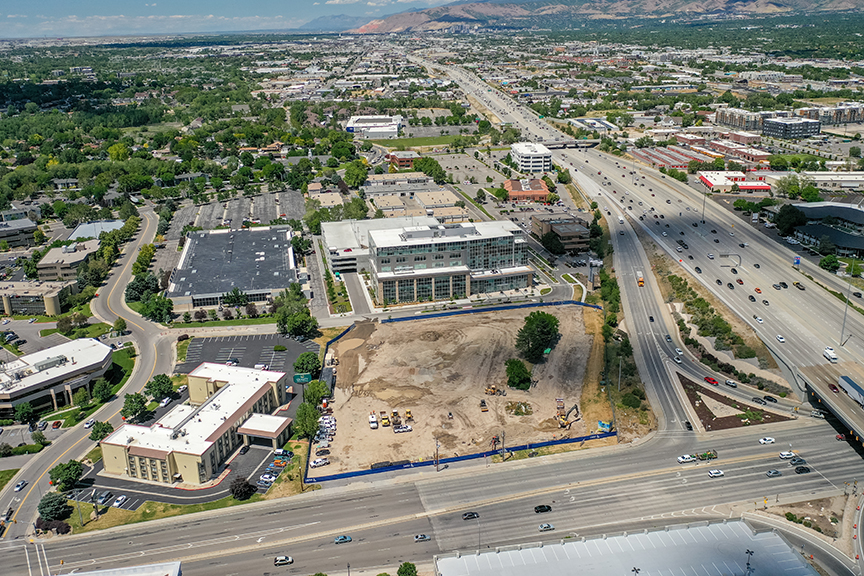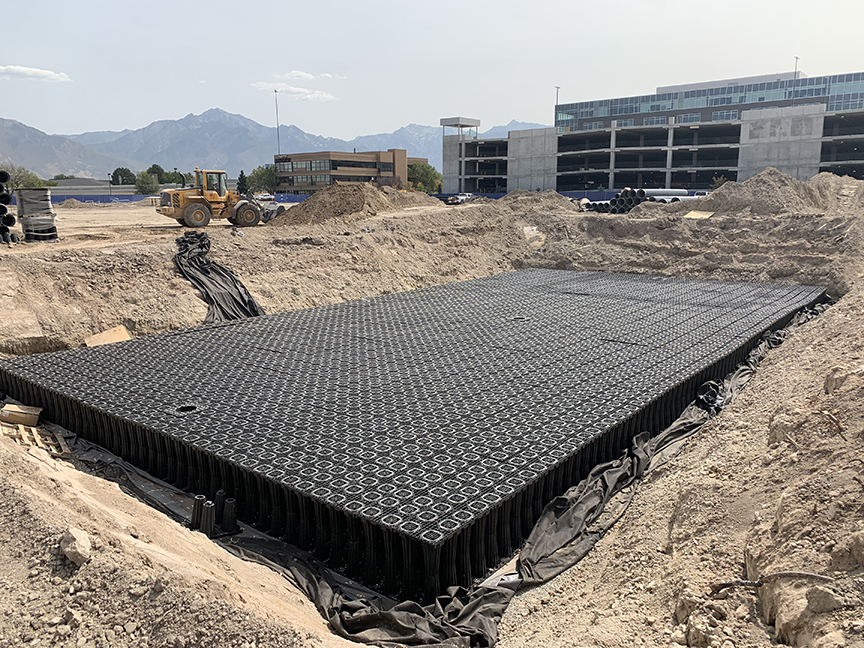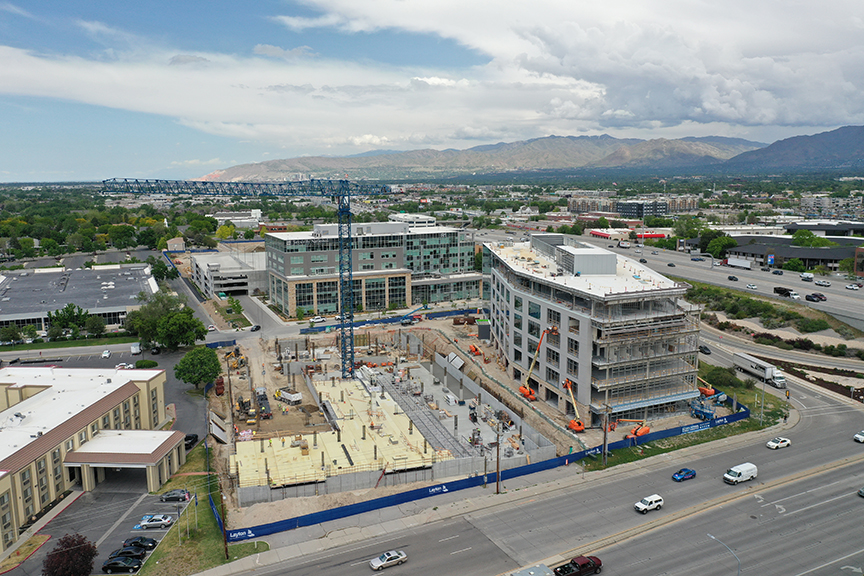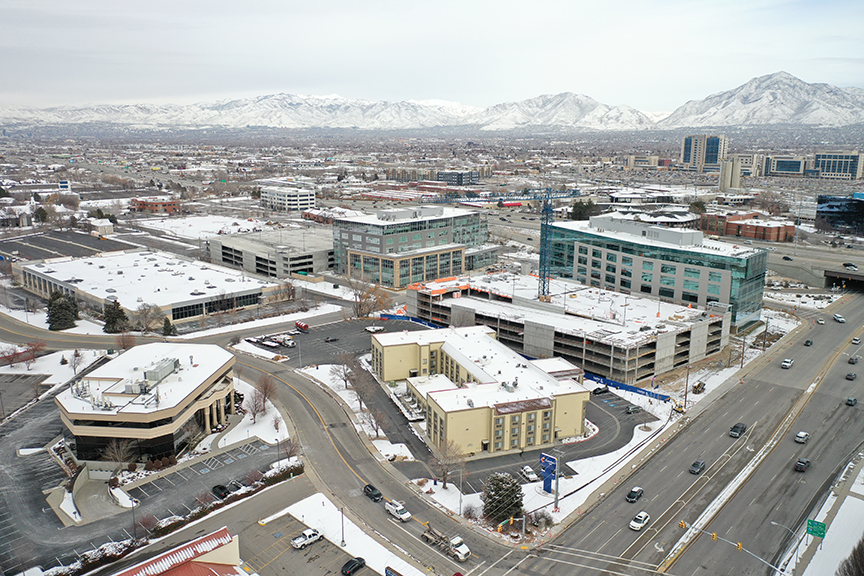Urban Stormwater Retention at Utah’s Security National Corporate Office
Protecting the water table is a vital priority for the drought-stricken West. Design and construction decisions that can replace and retain water in the system will help boost a future water supply. Commercial customers generally support that philosophy while expecting a stormwater system to meet cost and operational efficiencies.

Construction site limited by major highways
A prime example of implementing these efficiencies can be found at a land-locked development site in a growing city. When Security National Financial Corporation completed its corporate office – a new, 6-story Class A office building – it put additional strain on its 19-acre office campus in Murray, Utah. It made sense to continue growing in the same place because adding buildings to the same site helped improve the organization’s efficiency. Also, the location of the building gave it a valley-center placement, halfway between downtown Salt Lake City and Lehi, Utah’s “silicon slopes,” which was seen as a great help in recruiting employees.
Once a commitment was made for the company to grow its footprint there, careful planning was needed to make sure that the stormwater recovery at the site could accommodate current and future construction needs. Stormwater retention and detention provided a significant opportunity for innovation. With limited space and the area expected to change over time, CRS was challenged to design a drainage system to capture the site’s stormwater and naturally release as much as possible back into the water table.
Water Reuse By Using Geo-Cellular Building Blocks
To store more water in less available space, CRS chose to design a detention system using StormBrixx. This plastic geo-cellular system has a small footprint but allows a large amount of water to be reused, providing surface water retention, detention, and then infiltration into the water table. A stackable pillar configuration provides structural integrity, a high void ratio, and efficient water storage capacity.

Stormbrixx installed
At the Security National site, three Stormbrixx tanks at staggering depths allow water to flow by gravity into one another, maximizing capacity and sustainability. Altogether, brick bonding and cross bonding provide unparalleled capacity in a tight space, and the system is also stable with enough structural integrity to bury and efficiently use underutilized areas.
Designers placed two modular tanks under the parking lot in a tiered system connecting to a previously existing detention basin. Expanding capacity met the demand for retention and detention of the 19-acre site, including the master-planned expansion of office spaces and parking structures. The tanks’ location meant that they were easy to access for inspection and cleaning, simplifying silt management and maintenance for the owner.
As the second office building and new parking structure is completed, the complex is now functional with building blocks in place for future expansion.
Trash and Sediment Removal
The stormwater system also included using both swirl and continuous deflective separation to capture and retain trash and debris in a compact space. The Continuous Deflective Separation (CDS) hydrodynamic separator discharged clean runoff before finally releasing the water into the City’s storm drain system.

Stormwater management is critical in a congested site
Instead of multiple structures for bypass and treatment, as in traditional trash and sediment removal systems, the CDS requires a single structure and is capable of multiple inlet connections. A flume guides the water flow into the separation chamber, where water velocities within the section create a vortex. The vortex concentrates and traps floatable trash in the center of the separation chamber. Neutrally buoyant debris is captured in the screen aperture, with sediment settling into an isolated sump. Oils are trapped in a hydrocarbon baffle allowing water to move underneath, exiting the system.
Should a high-intensity event occur, the internal diversion weir directs a portion of flows greater than the design storm around the treatment chamber and over an internal bypass weir keeping the trash in the central cylinder. The system is low impact, low maintenance, and strategically placed to allow the site to evolve.

Parking garage nearing completion
Infrastructure Designed for the Future
This project is an excellent example of how a project team worked extensively with a community – Murray City – and the surrounding business owners for a master plan that integrated the new complex into the community, providing the appropriately sized infrastructure for future development. The utilities were sized appropriately to meet projected growth for the city within that area. Carefully planned stormwater retention used innovative techniques to impact its long-term effectiveness and ability to make the best use of its resource. While not necessary to complete the project scope, the design team distinguished themselves by keeping the big picture in mind.
For more information, contact Greg Nelson at greg.nelson@crsengineers.com

